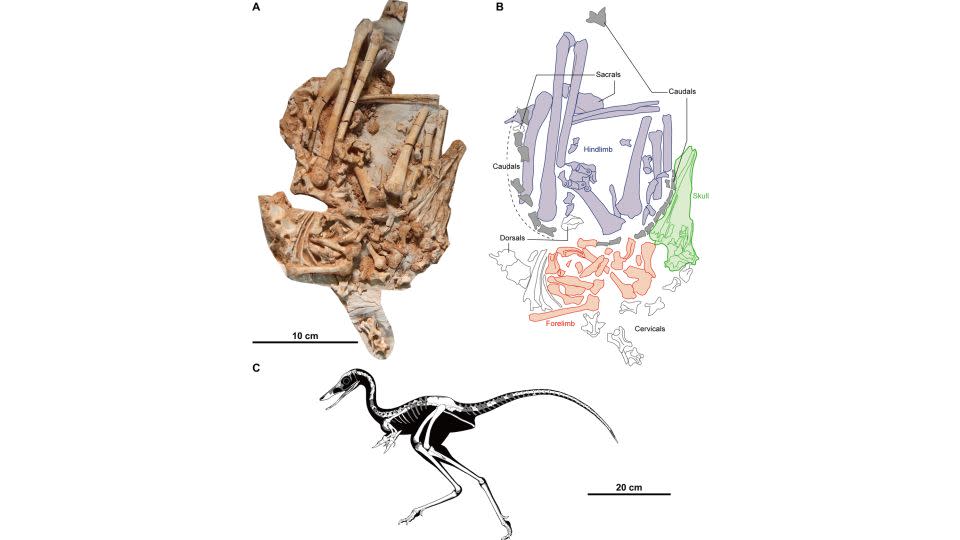Dinosaur from newfound species died in a pose that sheds light on evolution of bird behavior
Sign up for CNN’s Wonder Theory science newsletter. Explore the universe with news on fascinating discoveries, scientific advancements and more.
Death in the wild is often brutal and violent. But for one small, birdlike dinosaur in the late Cretaceous Period, the end of its life was relatively peaceful — it curled up to take a nap and never woke up.
That’s what scientists have interpreted from the pose of the dinosaur’s fossil skeleton. With the creature’s head tucked over its limbs and tail snugly wrapped around its body, its cozy posture resembled those of modern birds at rest, hinting that these dinosaurs didn’t just look like birds — they may have behaved like them, too.
Paleontologists excavated the dinosaur’s skull and nearly complete skeleton in the Gobi Desert at the Barun Goyot Formation in Mongolia, and most of the bones were still arranged in the animal’s original death pose, researchers reported Wednesday in the journal PLOS One.
The animal’s long neck wrapped around the right side of its trunk, and its head was tucked close to its side, resting atop the right knee. The hind limbs were folded underneath it, and most of the tail curved around the body’s left side.
The study authors identified it as an alvarezsaurid, a type of small theropod (bipedal meat-eating dinosaur) with a long tail and legs and short front limbs. Alvarezsaurids are part of a larger dinosaur group called maniraptorans, which includes birds and birdlike dinosaurs that were their closest relatives.
The small alvarezsaur’s posture emulated that of two other dinosaur fossils found in Mongolia that were also curled up in birdlike sleeping poses: Sinornithoides youngi and Mei long. Those two are troodontids, another type of dinosaur in the maniraptoran group, and one that’s more closely related to birds than alvarezsaurs were.

The new fossil suggests that this sleeping behavior may have been more common than expected among the non-avian relatives of the earliest birds, the researchers reported.
“We’ve all seen ducks sleeping with their heads tucked under their wings. And then you see this little dinosaur with the exact same sleeping posture,” said paleontologist Dr. Jingmai O’Connor, associate curator of fossil reptiles at the Field Museum of Natural History in Chicago.
“This is tangible evidence of behaviors that are today unique among birds. Now, we can actually say this is not a uniquely avian feature,” O’Connor, who was not involved in the study, told CNN.
Nearly intact fossil specimen
The scientists who examined the fossil determined it was a species new to science and gave it a fierce name: Jaculinykus yaruui. The genus name comes from Jaculus, a mythical dragon, and onykus, which means claw in ancient Greek, while its species name originates from yaruu, the Mongolian word for hasty or speedy.
Jaculinykus yaruui lived around 70 million years ago toward the end of the Cretaceous Period (about 145 million to 66 million years ago) and would have measured just over 3 feet (1 meter) long from nose to tail tip, said lead study author and paleontologist Kohta Kubo, a doctoral candidate in the Paleobiology Research Group at Hokkaido University in Japan.
“This specimen was considered a partial skeleton when it was discovered, but after its preparation, it represents a nearly complete and articulated skeleton preserving its life posture,” Kubo told CNN in an email. “It is the first definitive record of this posture in alvarezsaurs as well as early branching maniraptoran dinosaurs.”
Jaculinykus yaruui’s closest relative is a tiny alvarezsaurid named Shuvuuia deserti, Kubo said. Among the features that set it apart are the shape of its nostrils, the attachment of jaw muscles in the skull, and the shapes of its limb bones.
“It’s a nice specimen, and it’s always exciting to have new dinosaur diversity, especially in the alvarezsaurids,” O’Connor said.
Birdlike behaviors in dinosaurs
Alvarezsaurids aren’t the best-known dinosaur group, but they have long fascinated scientists with their drastically shortened forearms and hands, which in some species terminate in a single massive finger sprouting a claw like a spike.
“These types of fossils that are so well-preserved that they record behaviors are incredibly rare,” O’Connor said. “It’s great to have some additional evidence that definitely shows that this sleeping posture was more widespread.”
In modern birds, such behavior helps them to conserve body heat; it likely served a similar purpose for maniraptoran dinosaurs that also curled up at bedtime, according to the study. Over the course of their evolution, alvarezsaurs shrank in size. This “drastic miniaturization” may have led the non-avian dinosaurs to adopt the same thermoregulatory strategy used by their avian cousins, Kobu said.
What’s more, sleepy little Jaculinykus yaruui “highlights that this avian-like thermoregulatory behavior evolved prior to the origin of powered flight,” he added. “Jaculinykus is an important example that alvarezsaurids possess more similarities with living birds — not only in osteological features but also behavioral traits.”
Mindy Weisberger is a science writer and media producer whose work has appeared in Live Science, Scientific American and How It Works magazine.
For more CNN news and newsletters create an account at CNN.com

